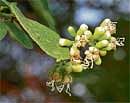Mite species named Mangalaus after ICAR chief

The outgoing chief of Indian Council of Agriculture Research, Mangala Rai, has been able to etch his name permanently in the annals of science – albeit in a slightly obscure branch.
Insect-hunters at Indian Agriculture Research Institute have discovered a new class (genus) of mite, which they named after their boss.IARI is a part of ICAR.
The researchers christened the genus of the new mite as Mangalaus. The species is yet to be typed fully and may take another month. Any living organism is scientifically described by its genus and species. For example humans are described as Homo sapiens. “We have named it after the director general because he has shown special interest in basic research in this area,” entomologist V V Ramamurthy who heads the IARI team told Deccan Herald.
Doducallu in Kannada
The new bug was identified three months back from Lasora creepers (Indian cherry) in the IARI farm. It’s a deciduous plant which is grown all over the country including the Western Ghats. It is called Doducallu in Kannada.
Crop scientists took three months for conducting low-temperature scanning electron microscope studies to find out that it belonged to a new genus. The christening, incidentally, puts Mangala Rai in the same league as his guru MS Swaminathan who headed the apex crop research agency three decades ago. In 2004, scientists at MS Swaminathan Research Foundation discovered a novel nitrogen-fixing soil bacterium from Pichavaram mangrove forest in Tamil Nadu, which can help plants extract phosphorus from the soil.
Mangalaus plant mite
It was baptised as Swaminathania salitolerans – after the MSSRF founding director who ushered in Green Revolution in the 1970s. Compared to ordinary house mites, the Mangalaus plant mite is 5-6 times smaller. It was collected from IARI farms in Delhi by the taxonomists of ICAR network project on insect biosystematics.
“So far only one species has been found. But there may be more,” Ramamurthy said.
Mangalaus is strikingly distinct from mites hitherto known. Invisible to naked eye, it reveals several unique characters when it is viewed under an electron microscope that magnifies its image manifold.
Commenting on the discovery, James Amrine from the West Virginia University, USA said, “This mite has an eye-like structure (ocelli) and represents a new genus.” Another foreign expert, Ronald Ochoa at the US Department of Agriculture said “The round area does look like an eye. But there is no report of such structure in this mite family.”
Incidentally, in July Rai was given an extension of six months – till December end – as the ICAR chief by the government as an earlier effort to find out his successor did not fructify.
Kalyan Ray in New Delhi
Deccan Herald is on WhatsApp Channels| Join now for Breaking News & Editor's Picks